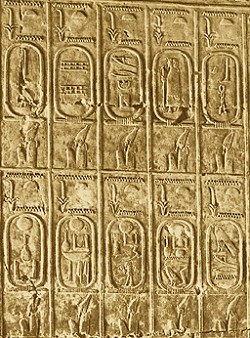
Nach den Unruhen im Zusammenhang mit der Thronfolge am Ende der 19. Dynastie stellte Sethnacht schließlich wieder die Ordnung her. Nach einer nur wenige Jahre währenden Regierung folgte ihm Ramses III. auf den Thron. Er mußte sich mehreren Angriffen der Libyer und der Seevölker stellen. Innere Unruhen waren das Ergebnis einer wirtschaftlichen Krise, die zum Teil durch Korruption und Nachlässigkeit vieler Beamter verursacht worden war. Dies führte schließlich zu sehr hohen Getreidepreisen. Der Staat war nicht mehr in der Lage, die Arbeiter von Deir el-Medina zu versorgen, die endlich sogar streikten. Nach dem Tod Ramses' III. (er wurde wahrscheinlich ermordet) regierte Ramses IV. etwa sechs Jahre lang. Seine Nachfolger waren Ramses V., VI., VII. und VIII., die jeweils nur kurze Zeit regierten. Unter Ramses IX., X. und XI. wurden Prozesse gegen die Räuber geführt, die seit Jahren die Gräber im Königsgräbertal geplündert hatten. Die Papyri, die die Protokolle dieser Gerichtsverfahren enthalten, gewähren uns nicht nur Einsicht in das ägyptische Rechtssystem, sondern auch in die Vorgehensweise der Räuber und in die weitreichende Korruption der Beamtenschaft. Unter Ramses XI. brach ein Bürgerkrieg aus, wobei der Tempel von Medinet Habu erstürmt und teilweise zerstört wurde. Der Königssohn von Kusch Panehsi konnte den Aufstand unterdrücken. Von dieser Zeit an war Ramses XI. nur noch dem Namen nach König. Die Regierung von Oberägypten lag in den Händen des Generals und Hohenpriesters des Amun Herihor, diejenige von Unterägypten in den Händen von Smendes. Herihor konnte Panehsi wieder nach Nubien zurücktreiben. Ein Orakel im Tempel von Karnak machte deutlich, daß die Götter die mächtige Position des Herihor unterstützten. Oberägypten war jetzt der Gottesstaat des Amun. Auf Herihor folgte dessen Sohn Pianchi. Die Wissenschaftler sind noch immer uneinig über das genaue Verhältnis zwischen Herihor und Pianchi wie auch über die Reihenfolge ihrer Herrschaft.